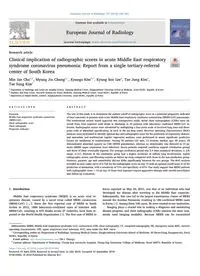
2018 Clinical implication of radiographic scores in acute Middle East respiratory syndrome coronavirus pneumonia_ Report PDF
Preview 2018 Clinical implication of radiographic scores in acute Middle East respiratory syndrome coronavirus pneumonia_ Report
Contents lists available at ScienceDirect European Journal of Radiology journal homepage: www.elsevier.com/locate/ejrad Research article Clinical implication of radiographic scores in acute Middle East respiratory syndrome coronavirus pneumonia: Report from a single tertiary-referral center of South Korea Min Jae Chaa,1, Myung Jin Chunga,⁎, Kyunga Kimb,c, Kyung Soo Leea, Tae Jung Kima, Tae Sung Kima a Department of Radiology and Center for Imaging Science, Samsung Medical Center, Sungkyunkwan University School of Medicine, Seoul 06351, Republic of Korea b Statistics and Data Center, Research Institute for Future Medicine, Samsung Medical Center, Seoul 06351, Republic of Korea c Department of Digital Health, SAIHST, Sungkyunkwan University, Seoul 06351, Republic of Korea A R T I C L E I N F O Keywords: Middle East respiratory syndrome coronavirus (MERS-CoV) Chest radiographic score Chest radiograph Prognostic indicator A B S T R A C T The aim of this study is to determine the earliest cutoff of radiographic score as a potential prognostic indicator of fatal outcomes in patients with acute Middle East respiratory syndrome coronavirus (MERS-CoV) pneumonia. The institutional review board approved this retrospective study. Serial chest radiographies (CXRs) were ob- tained from viral exposure until death or discharge in 35 patients with laboratory confirmed MERS-CoV in- fection. Radiographic scores were calculated by multiplying a four-point scale of involved lung area and three- point scale of abnormal opacification, in each of the six lung zones. Receiver operating characteristics (ROC) analyses were performed to identify optimal day and radiographic score for the prediction of respiratory distress, and univariate and multivariate logistic regression analyses were performed to assess significant predictive factors for intubation or tracheostomy. Among 35 patients (22 men, 13 women; median age: 48 years), 25 demonstrated abnormal opacity on CXR (MERS pneumonia), whereas no abnormality was detected in 10 pa- tients (MERS upper respiratory tract infection). Seven patients required ventilator support (intubation group) and three of them eventually expired. The average incubation period was 5.4 days (standard deviation, ± 2.8; range, 2–11). Patients in the intubation group had a higher incidence of diffuse lung involvement, higher radiographic scores, and fibrosing sequela on follow up study compared with those in the non-intubation group. However, patients’ age and comorbidity did not differ significantly between the two groups. The ROC analysis revealed an area under curve of 0.726 for the radiographic score on day 10 with an optimal cutoff score of 10 for prediction of intubation, with a sensitivity of 71% and specificity of 67%. Our study suggest that MERS patients with radiographic score > 10 on day 10 from viral exposure require aggressive therapy with careful surveillance and follow-up evaluation. 1. Introduction Middle East respiratory syndrome (MERS) is an acute viral re- spiratory disease, caused by a novel virus called MERS coronavirus (MERS-CoV) [1,2]. Since the first reported case of MERS in Saudi Arabia in 2012, 1888 laboratory-confirmed cases of infection with MERS-CoV, resulting in 670 deaths across 27 countries, have been re- ported to the World Health Organization [3]. The first case of MERS in Korea reported on May 20, 2015, was that of an individual who had developed the disease after traveling to the Middle East countries. Subsequently, this case led to the largest transmission cluster of MERS outside the Arabian Peninsula, resulting in 186 confirmed MERS cases in Korea [4]. Among these 186 cases, 36 were treated in our institution. Imaging plays a crucial role in making a diagnosis and monitoring disease progress, and chest radiography (CXR) remains the most com- monly used imaging modality. Because MERS can be transmitted https://doi.org/10.1016/j.ejrad.2018.09.008 Received 19 April 2018; Received in revised form 12 July 2018; Accepted 10 September 2018 Abbreviations: MERS, Middle East respiratory syndrome; CoV, coronavirus; CXR, chest radiography; CT, computed tomography; ER, emergency room; ROC, receiver operating characteristic; URI, upper respiratory tract infection; AUC, area under the ROC curve ⁎ Corresponding author at: Department of Radiology, Samsung Medical Center, Sungkyunkwan University School of Medicine, 50 Ilwon-Dong, Kangnam-Ku, Seoul 06351, Republic of Korea. 1 Current address: Department of Radiology, Chung-Ang university hospital, Chung-Ang University College of Medicine, Seoul 06973, Republic of Korea. E-mail address:
